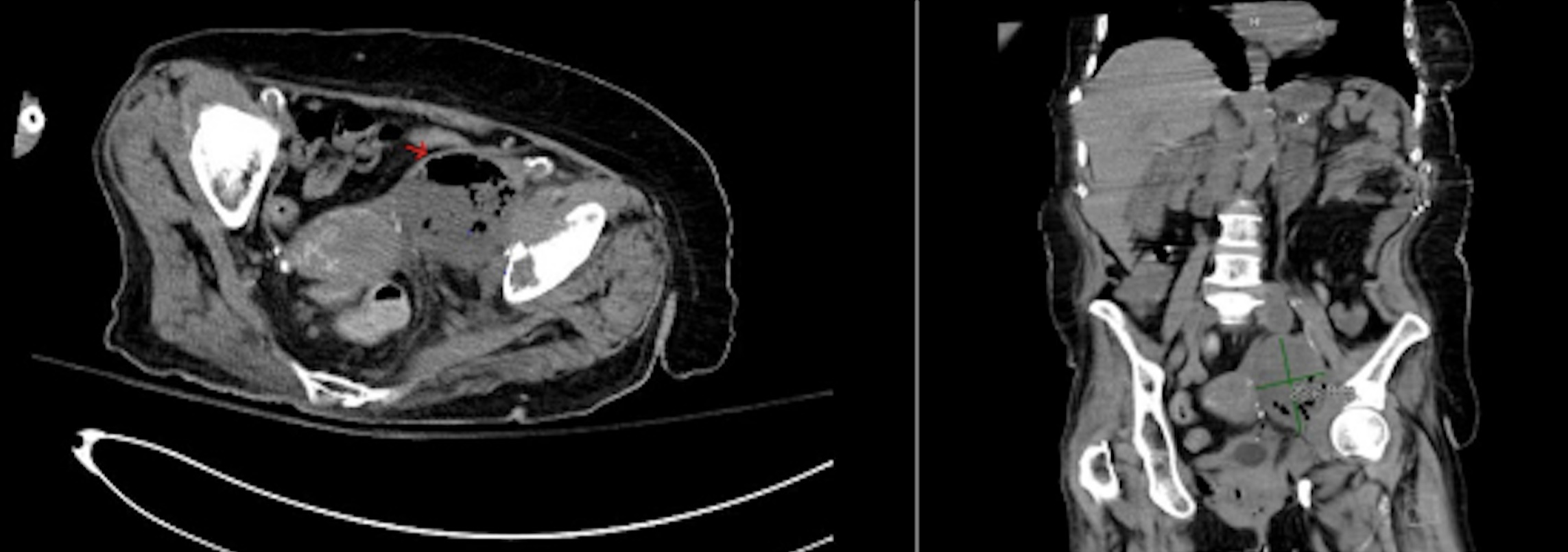Back


Poster Session C - Monday Afternoon
Category: Colorectal Cancer Prevention
C0192 - Clostridium sordellii Pelvic Abscess as the First Sign of an Underlying Gastrointestinal Malignancy
Monday, October 24, 2022
3:00 PM – 5:00 PM ET
Location: Crown Ballroom

Has Audio

Genesis Perez Del Nogal, MD
TTUHSC
Odessa, Texas
Presenting Author(s)
Genesis Perez Del Nogal, MD, Sailaja Devi Saragadam, MD, Kalyan Chakrala, DO
TTUHSC, Odessa, TX
Introduction: Clostridium sordellii is a rare gram-positive anaerobe associated to cause lethal infections after childbirth, penetrating injuries, and routine gynecological procedures. Very few cases of C. sordellii infection in patients with underlying malignancy have been reported. Here we present a case of septic shock with C. sordellii as the first sign of an underlying advanced rectal carcinoma.
Case Description/Methods: A 68-year-old female with a history of well-controlled diabetes came to the hospital with nonradiated left hip pain associated with fevers, and generalized weakness for four days. She denied history of recent falls, rheumatological diseases, steroid use, and weight loss. On arrival, the patient was hypotensive and tachycardic. Physical examination was significant for non-distended abdomen with approximately 5x5cm irregular tender suprapubic mass with erythema on the overlying skin, and externally rotated and abducted left hip with severe tenderness over the left hip joint. Laboratories evidenced leukocytosis. CT Abdomen showed 7.6x5.7x5.5 cm poorly marginated gas containing soft tissue mass in the left pelvis suspicious of an abscess with an irregular osteolytic lesion of the left acetabulum and superior pubic ramus (figure 1). MRI revealed osseous lesions involving numerous bones and a large lesion in the L3 vertebral body, indicating malignancy. The clinical picture was consistent with septic shock, and the pelvic abscess was the likely source in the setting of underlying malignancy. Sepsis protocol was initiated, cultures were sent, and the patient was started on antibiotics. Pelvic abscess fluid grew C. sordellii in the anaerobic bottle. Pathology report of the pelvic bone confirmed Squamous cell carcinoma with basaloid features, likely rectal carcinoma with no histopathological evidence of osteomyelitis.
Discussion: Historically, Clostridium species like C. septicum have been linked with GI malignancies. The reason for this connection is thought to be due to damage to the normal mucosa barrier from ulceration seen in GI malignancies, which can lead to hematogenous invasion. C. sordellii infections are also increasingly being associated with GI and GU malignancies, posing the question of whether we need to be more aggressive in screening these patients for underlying cancers. This could further help in early screening and diagnosis of underlying malignancies which can improve the mortality outcomes.

Disclosures:
Genesis Perez Del Nogal, MD, Sailaja Devi Saragadam, MD, Kalyan Chakrala, DO. C0192 - Clostridium sordellii Pelvic Abscess as the First Sign of an Underlying Gastrointestinal Malignancy, ACG 2022 Annual Scientific Meeting Abstracts. Charlotte, NC: American College of Gastroenterology.
TTUHSC, Odessa, TX
Introduction: Clostridium sordellii is a rare gram-positive anaerobe associated to cause lethal infections after childbirth, penetrating injuries, and routine gynecological procedures. Very few cases of C. sordellii infection in patients with underlying malignancy have been reported. Here we present a case of septic shock with C. sordellii as the first sign of an underlying advanced rectal carcinoma.
Case Description/Methods: A 68-year-old female with a history of well-controlled diabetes came to the hospital with nonradiated left hip pain associated with fevers, and generalized weakness for four days. She denied history of recent falls, rheumatological diseases, steroid use, and weight loss. On arrival, the patient was hypotensive and tachycardic. Physical examination was significant for non-distended abdomen with approximately 5x5cm irregular tender suprapubic mass with erythema on the overlying skin, and externally rotated and abducted left hip with severe tenderness over the left hip joint. Laboratories evidenced leukocytosis. CT Abdomen showed 7.6x5.7x5.5 cm poorly marginated gas containing soft tissue mass in the left pelvis suspicious of an abscess with an irregular osteolytic lesion of the left acetabulum and superior pubic ramus (figure 1). MRI revealed osseous lesions involving numerous bones and a large lesion in the L3 vertebral body, indicating malignancy. The clinical picture was consistent with septic shock, and the pelvic abscess was the likely source in the setting of underlying malignancy. Sepsis protocol was initiated, cultures were sent, and the patient was started on antibiotics. Pelvic abscess fluid grew C. sordellii in the anaerobic bottle. Pathology report of the pelvic bone confirmed Squamous cell carcinoma with basaloid features, likely rectal carcinoma with no histopathological evidence of osteomyelitis.
Discussion: Historically, Clostridium species like C. septicum have been linked with GI malignancies. The reason for this connection is thought to be due to damage to the normal mucosa barrier from ulceration seen in GI malignancies, which can lead to hematogenous invasion. C. sordellii infections are also increasingly being associated with GI and GU malignancies, posing the question of whether we need to be more aggressive in screening these patients for underlying cancers. This could further help in early screening and diagnosis of underlying malignancies which can improve the mortality outcomes.

Figure: Figure 1. CT Abdomen and Pelvis without contrast, different views showed 7.6 x 5.7 x 5.5 cm poorly
marginated gas containing soft tissue mass in the left pelvis suspicious for an abscess.
marginated gas containing soft tissue mass in the left pelvis suspicious for an abscess.
Disclosures:
Genesis Perez Del Nogal indicated no relevant financial relationships.
Sailaja Devi Saragadam indicated no relevant financial relationships.
Kalyan Chakrala indicated no relevant financial relationships.
Genesis Perez Del Nogal, MD, Sailaja Devi Saragadam, MD, Kalyan Chakrala, DO. C0192 - Clostridium sordellii Pelvic Abscess as the First Sign of an Underlying Gastrointestinal Malignancy, ACG 2022 Annual Scientific Meeting Abstracts. Charlotte, NC: American College of Gastroenterology.

